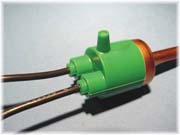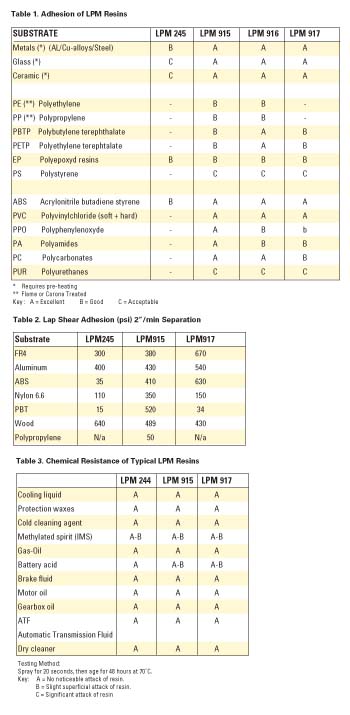
The solution is low-pressure molding. LPM is the most economic and effective way to protect printed circuit boards in environments that range from the benign to the very hostile. Today's polyamide hot melts have a greater range of operating temperatures, have greater chemical resistance and offer adhesion to a greater number of substrates than ever before. The cost of these materials is inexpensive per part when compared to two-part mixed liquids, and the risk of failure due to off-ratio mixing or unmixed material is eliminated. This technology eliminates the need for long cure times and cure ovens, for batch processing, and the need to put finished assemblies in a housing that requires either chemical or mechanical fasteners to assemble. It gives manufacturers the flexibility to eliminate tens- if not hundreds- of feet from their assembly lines with the removal of in-line cure ovens and packaging stations. Simply put, this material becomes a housing and environmental barrier.
But I'm Not a Molder
Establishing an LPM process may sound like a major undertaking, but just the opposite is true. The material, equipment and mold technology offered today by turnkey solution providers such as Lighthouse Molding Inc. allow users to set up their own LPM operation in a relatively short time with a comparatively small capital investment. The temperatures needed to process LPM materials range from 190
The Right Molding Material
Bostik LPM molding resins offered through Lighthouse Molding are high-performance dimer-acid polyamide polymers. These thermoplastic resins have a long history of successful use in demanding automotive applications, making them suited for the rigors of the electronics industry.
The two key characteristics of polyamide molding resins are melt viscosity and softening point. Typical application viscosity is very low (around 3,000 cps), allowing the resin to easily fill the mold cavity and flow around components for complete encapsulation. Softening points vary from 150


How Do I Get Started?
Getting started requires nothing more than contacting one of Lighthouse Molding's sales representatives and initiating a prototype order. To initiate a prototype, the following questions must be answered.- Is this a new application or current production?
- If this is a current production, what encapsulant is currently being used?
- In what type of environment will this assembly be used?
- Is adhesion or chemical resistance the most important factor? Are both important?
- Is a flexible or rigid material needed?
- Is artwork available?
- Are samples available?
Using this information, we will have enough information to get started on a prototype program for you. Prototypes can be done with a single-cavity aluminum mold and can include 50 sample pieces. Once we have provided you with prototype pieces that are dimensionally accurate and pass all applicable testing criteria, we can begin outlining your production needs. Production needs will hinge on annual volumes, complexity/size of the part and how many different assemblies will be run on one piece of equipment. Our standard system, Lighthouse Auto-Lite, comes with a positive-rod-displacement injection system, an integrated-melt system, a 3-lb melt tank, pneumatic clamping, and a dual shuttle, and it accepts a 12" mold base. This system can be upgraded with gantries and robots, conveyors, and multiple mold sets. With the right application, Lighthouse can supply you with a "lights out" LPM system.
Building A Better Mousetrap
Traditional hot-melt thinking says that gear pumps must be used if hot melts are being applied. While that thinking works for adhesives, we feel that a more accurate and user-friendly system should be used for electrical and electronic packaging. The problems associated with traditional gear pumps include gear slip, gear wear and accuracy. Our positive-rod-displacement system gives users the precision needed to accurately overmold their electronic assemblies. With a PLC controller, customers can set, monitor and track each shot into the mold, maintaining complete control over the molding process and ensuring the quality of each part.Turnkey Vendors
Bostik-US (Middleton, MA):Inventor and global leader in low-pressure molding materials. All of Bostik's LPM materials are manufactured in the United States. Bostik is a QS-9000, ISO-9000 and A2LA vendor.
Hi-Star Controlled Motion (Lapeer, MI): 40 years of experience in hot-melt applications makes this company the technological leader in LPM application technology. As an integrator, it has the ability to take molding equipment and integrate it into a manufacturing system.
For more information, contact Lighthouse Molding at (248) 922-1926 or visit http://www.lighthousemolding.com.